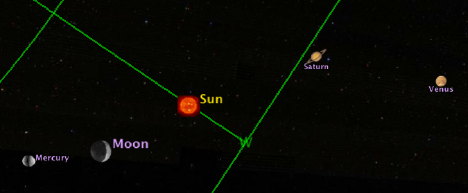
Just what I was looking for to illustrate an upcoming post: HeyWhatsThat has posted an improved dedicated planisphere for Google Sky, with plenty of display and animation options. Take it away Michael Kosowsky:
Thanks to everyone for the great reception you’ve given the planisphere.
Three additions: I’ve added the Sun, Moon and planets; you can now animate the night sky; and I’ve put together a web page to simplify the process of creating a planisphere.
To try it all out, head over here. Find yourself on the map. Select the next to last option (a full day at one hour intervals) and hit “Submit.” When Google Earth opens up with our overlays, open the “Sun, Moon, planets” layer and double-click on “Sun” to center it, then start the animation. You should be able to watch the Sun cross your horizon. (Actually, your horizon crosses the Sun; you’ll understand what I mean when you try it.)
Quick tips for running the animation: A slider appears on the top right of the window when you load an animation. Hit the big arrow to the right and stuff should move. There’s a cursor you can manually drag. Click on the icon that looks like a clock to the left of the slider to set options. More documentation here and at the planisphere FAQ.
I have early reports of things not working quite right under Vista, in particular lots of overlapping copies of the horizon and grids appearing at once. If this happens, make sure the animation slider isn’t spread out to display an interval — there are tiny arrows on top of the slider to widen and narrow the interval, and you want it reduced to just a line — and try turning off some layers. If you encounter this problem and find a solution, please let me know.
KML hackers:
- Can you dynamically change the viewpoint as the animation proceeds, e.g. <TimeSpan>’d <LookAts>? Then we could make the sky rotate around a fixed viewpoint, just like desktop planetaria.
- Any way to set the time on the animation slider when our KML loads, sort of a time analog of <flyToView>?
- Can you tie a NetworkLink to the animation slider? The idea is that if you moved the slider cursor to a particular time, I’d send you the overlays for that moment.
Enjoy, MK
While the default layers also have the positions of the Moon and planets, HeyWhatsThat’s network link has the Sun, and can be used to easily find current positions without needing to fiddle with the time browser.